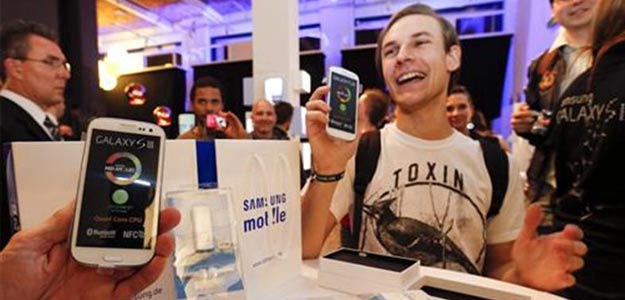Samsung’s crisis culture – a driver and a drawback

In his 1997 book, Samsung Chairman Lee Kun-hee wrote that a successful company needs a “heightened sense of crisis”, so that it always looks ahead even when it’s doing well, and needs to be able to respond to change.
It’s a credo that has driven Samsung Electronics to become the world’s biggest technology firm by revenue – it sells more televisions, smartphones and memory chips than anyone else – and makes the group a must-visit case study for a stream of Chinese firms seeking to tap the secrets of Korean success.
But, in the wake of last month’s damaging U.S. patent ruling, which Samsung has said it will appeal – the Korean group was fined more than $1 billion after a jury found it had copied key features of Apple Inc’s iPhone – the group’s top-down command structure and decision-making process are blamed for stifling creativity.
What’s been good for getting things done quickly, such as making bold decisions on big investments in chips and display screens, may not now best suit a company that needs to shift from being a ‘fast follower’ – quick to match others’ products – to an innovator.
Within Samsung, where some designers feel overlooked and undermined, there are calls for a change of tack.
The ‘constant crisis’ has worked well, helping Samsung overtake Japanese technology brands Sony, Sharp and Panasonic in chips, TVs and displays, end Nokia’s decade-long supremacy in handsets and overtake Apple in smartphones.
But that has come with a big reputational hit – that Samsung makes knock-off products.
MOVING HEAVEN AND EARTH
“It’s a crisis of design,” JK Shin, head of Samsung’s mobile division told staff in February 2010 as Samsung worked on its first Galaxy phone in a panicky response to the iPhone’s smash-hit debut, according to an internal memo filed to a U.S. court as part of Apple’s lawsuit.
“Influential figures outside the company come across the iPhone, and they point out that ‘Samsung is dozing off.’
“All this time, we’ve been paying all our attention to Nokia, and concentrated our efforts on things like ‘folder’, ‘bar’, ‘slide,’ yet when our UX (user experience) is compared to the unexpected competitor Apple’s iPhone, the difference is truly that of Heaven and Earth.”
The sense of crisis and urgency to catch Apple drove Samsung designers and engineers to opt for a concept that best matched the look and feel of the iPhone, according to one Samsung designer, who isn’t authorized to talk to the media and didn’t want to be identified.
“Designers have lots of unique and creative ideas, but these have to be loved by the top decision-makers. The problem was, because they were so fascinated by the Apple design, these ideas weren’t really satisfactory to please the top level,” said the designer.
“I think elsewhere top managers respect their chief designer’s decision, but at Samsung, they overrule designers and have the final say about what design we go with. That limits our capability. To be better than a good fast follower, Samsung needs a more horizontal culture and to empower designers.”
A Samsung executive, who didn’t want to be named, countered that the group had started out with little innovation – it struggled even to make simple black and white TVs – but now drives new ideas internally through incentives and bonuses, with Lee himself very interested in new technology and design.
MORE WOW
One recent example of that top-heavy command structure came less than a fortnight before the launch of Samsung’s Galaxy S III smartphone in May, when vice chairman Choi Gee-sung ordered half a million blue phone cases to be thrown away as the design, with thin, silver stripes, was unsatisfactory, according to a person familiar with the matter.
After a number of tweaks, Choi approved the final design on a Sunday just 10 days before launch, triggering an initial supply bottleneck and delaying shipments of some 2 million units, according to some analysts.
Similarly, when Choi visited Samsung’s U.S. telecoms operation a year ago, internal documents filed to the court during the U.S. patent battle with Apple showed managers there were worried about a lack of initiatives to impress him.
“Overall plan is OK, but we are lacking a WOW idea to share with GS (Choi). Generally, lacking confidence in our plan to ‘beat Apple’.”
The react-fast philosophy is a far cry from how Apple worked. Christopher Stringer, a 17-year Apple design veteran, told the U.S. court that around 16 “maniacal” individuals from all over the world used to brainstorm around a kitchen table to come up with the company’s mobile products.
By contrast, Samsung’s design sanctum looks much like any other Samsung department, a Dilbert sprawl of desks and cubicles with framed aphorisms from the founding family on the walls: “Be with Customers”, “Create Products that Contribute to Humanity” and “Challenge the World, Create the Future.”
“It’s pretty much a top-down, hierarchical culture that doesn’t do any good in inspiring creativity,” the designer added. “I don’t think it’s a unique Samsung problem, but one that plagues South Korean society as a whole. Samsung is making efforts to change it, but it’s still very much top-down.”
“Probably what we need now is the creative environment that Silicon Valley boasts.”
“SAMSUNG MEN”
Living up to its reputation for moving swiftly and nimbly in an increasingly competitive market, Samsung’s mobile product life cycle is getting shorter – it introduces a new product around every six months. In a surprise last Wednesday, Samsung unveiled a smartphone using Microsoft’s <MSFT.O> latest mobile software, rushing the announcement just days before the highly anticipated launch of Nokia’s version.
“Regardless of any hindrance, Samsung will continue to provide outstanding, innovating and unique products that stand out in the industry,” Samsung’s mobile chief Shin said at Europe’s biggest electronics show in Berlin.
Shin has also praised the company’s “diligent and exemplary” elite workforce, the so-called “Samsung men” trained in the 1990s with a textbook called “New Samsung Management” that summarised chairman Lee’s remarks and his sense of crisis.
Lee, who took over as chairman from his father and group founder in 1987, stepped down in 2008 after he was convicted of embezzlement and tax evasion, but returned within two years following a presidential pardon. He marked his return with his familiar refrain.
“We’re in a real crisis. Top global companies are reeling and (I’m) not sure what will happen to Samsung. Most products and businesses that represent Samsung today will be gone in 10 years’ time. We should start again. There’s no time to waste.”
That summer, Samsung saw its telecoms profit halved as Apple captured consumers’ hearts and wallets. But it swiftly rebounded with its Galaxy line-up and has posted record profits each year since. Annual profit this year is likely to top $22 billion, up 45 per cent from 2010.
But the crisis culture is wearing thin for some.
“It does keep people agile and alert, but people joke that once you work more than five years at Samsung you’ve probably heard it more than enough and think it more of a repetitive cycle,” said a Samsung chip developer, who wasn’t authorised to talk publicly about the company. “You just get used to these things.”
Even 70-year-old billionaire Lee may be mellowing.
Briefed after the bruising Apple defeat, Lee said only: “Deal with it well,” according to a person familiar with the matter.
Copyright @ Thomson Reuters 2012









